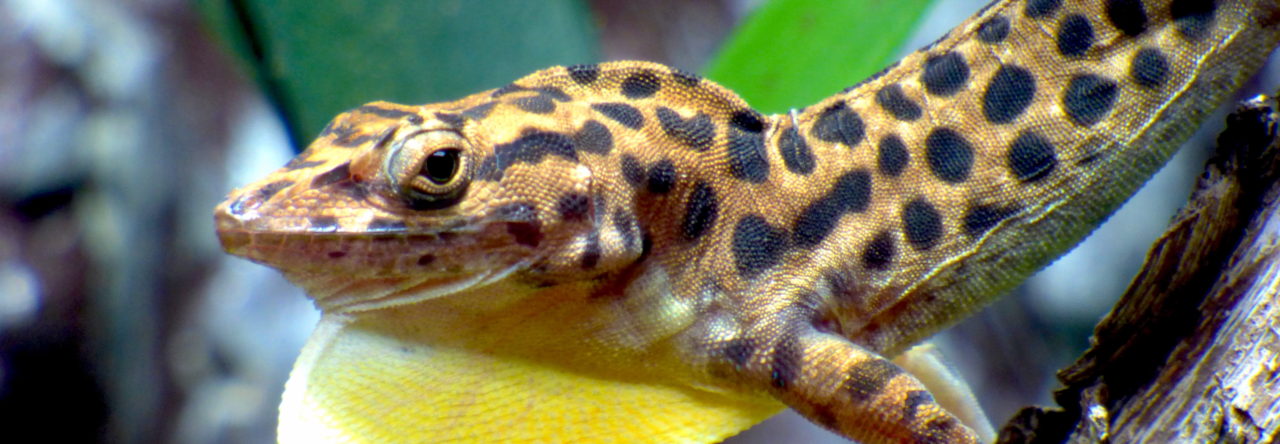Major Anole Annals contributor Martha Muñoz gave a brilliant talk at the Evolution meeting as an awardee of a well-deserved ‘Young Investigator’ award from the American Society of Naturalists. In her talk, Muñoz discussed how two classic papers by Janzen (1967) and Huey et al. (2003) influenced the way she thinks about the interplay between behavior, physiology, and evolution. Not surprisingly, Anolis lizards played a leading role in her exposition.
Martha’s talk, entitled “Janzen’s hypothesis meets the Bogert effect: a synthesis nearly 100 years in the making”, started by describing Janzen’s hypothesis. In short, Janzen (1967) predicted that physiological differences among populations across altitudinal bands would be stronger in tropical mountains than in temperate ones. The main argument was that populations can more easily adapt to a given temperature range in tropical environments because these ranges are stable throughout the year, whereas the temperatures of different altitudinal bands overlap more in temperate areas due to seasonal variation.

Martha explains how day and night temperatures in the tropics mirror seasonal patterns in temperate and tropical climates.
Expanding on Janzen’s idea, Muñoz hypothesized that diurnal and nocturnal temperature variation in a single tropical mountain could also generate differences in physiological divergence among lowland and highland populations. The idea was that daytime temperatures were variable with overlap across elevation (similar to the seasonal picture in temperate areas) and nighttime temperatures were more constant and differed between elevations (similar to the seasonal picture in tropical areas).
To test this, Martha sampled populations in the Dominican Republic at sites ranging in elevation from sea level to 2400m. She then analyzed heat and cold tolerance of several species of anoles from the Anolis cybotes group. Results on cold tolerance (CT min) seem to agree with Janzen’s hypothesis: cold tolerance strongly covaries with altitude at night, with higher elevation populations having lower critical thermal minimums. Interestingly, however, heat tolerance (measured as CT max) was not at all associated with elevation.
Why did Janzen’s hypothesis fail to explain the evolution of heat tolerance across the altitudinal range? This question led to a key point of Muñoz’s talk: Janzen’s hypothesis might fail to predict evolution of CT max because it is agnostic about behavior. In the case of ‘cybotoid’ anoles, lizards from different altitudes could actively adjust their habitat use to achieve optimal temperatures. As a consequence, thermoregulatory behavior could forestall evolution of physiology in heat tolerance. By studying habitat use across different elevations, Muñoz showed that, although anoles behave as thermo-conformers at low elevations, they clearly thermoregulate at high elevations. In other words, anoles were at similar temperatures to the average available substrates in lowlands but their body temperatures were significantly higher than perches at higher elevation.

Martha explains how the thermoregulation can lead to slower evolution in a trait (the Bogert effect)
This was at least partially explained by habitat use differences: anoles at high elevations perched most frequently on boulders, which are on average about 5º C warmer than trees –the most used substrate in low altitudes. In fact, 90% of the trees Martha sampled at these high elevation sites were lower in temperature than the preferred temperature of the lizards! These data indicate that anoles from the A. cybotes group have buffered natural selection in physiology by means of behavioral adjustments –a phenomenon known as the Bogert effect (also called behavioral inertia; Bogert 1949).
Finally, the talk had a third part. And yes, it got even more interesting! Due to the observed habitat use differences in high latitudes, Muñoz and her collaborators predicted that although behavior could buffer physiological evolution on heat tolerance, it could spur evolutionary change in ecologically-relevant morphological traits (the behavioral drive hypothesis). Specifically, they predicted that increased use of boulders (for thermoregulation) at high elevations should drive morphological shifts in traits related to boulder use: head and limb morphology. They found evidence for these hypothesized morphological differences: high elevation lizards had higher head heights and longer hindlimb, in agreement with functional predictions. Finally, a captive breeding experiment confirmed that these differences were the consequence of genetic changes and not simply due to developmental plasticity.
Martha’s research is a great example of how, as Huey said, studying behavior can be crucial to improve our understanding of evolutionary processes. We are looking forward to hear about future research from the Muñoz lab, which is about to open at Virginia Tech!
References:
Janzen, D.H. 1967. Why mountain passes are higher in the tropics. American Naturalist 101:233–249
Muñoz, M.M., Losos, J.B. Thermoregulation simultaneously promotes and forestalls evolution in a tropical lizard. (Accepted pending minor revision). American Naturalist.



Leave a Reply